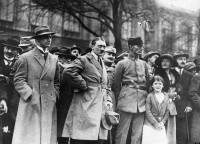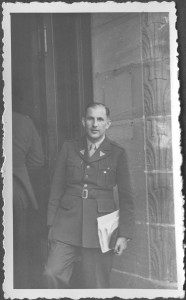 The diary of Nazi Party leader, racist philosopher and close Hitler confidant Alfred Rosenberg was officially handed over to the US Holocaust Memorial Museum on Tuesday. Museum staff must have had access to the diary before then, because the entire 400 pages plus of loose-leaf paper have been digitized and uploaded to the web. Each page is scanned in readably high resolution and accompanied by a transcript.
The diary of Nazi Party leader, racist philosopher and close Hitler confidant Alfred Rosenberg was officially handed over to the US Holocaust Memorial Museum on Tuesday. Museum staff must have had access to the diary before then, because the entire 400 pages plus of loose-leaf paper have been digitized and uploaded to the web. Each page is scanned in readably high resolution and accompanied by a transcript.
“The Museum encourages people to think about why the Holocaust happened and how it was possible in such an advanced society,” said United States Holocaust Memorial Museum Director Sara J. Bloomfield. “The Rosenberg diary will add to our understanding of the ideas that animated the extremist ideology of Nazism. We are grateful to our partners at ICE who helped us secure this important piece of history, a significant addition in our urgent efforts to rescue the evidence of the Holocaust.”
 Alfred Rosenberg played a key role in the development of Nazi anti-semitic policy, both philosophically and practically. In 1930, he wrote The Myth of the Twentieth Century, an impenetrable tome nobody read about the noble Aryan struggle against the insidious Jew, liberal and Bolshevik. He was instrumental in promoting the theory of Lebensraum and as Reich Minister for the Occupied Eastern Territories organized the deportations of Eastern European Jews to concentration camps. As head of the Einsatzstab Reichsleiter Rosenberg (Reichsleiter Rosenberg Taskforce), he was also directly responsible for the orgy of looting of art and antiquities from occupied territories.
Alfred Rosenberg played a key role in the development of Nazi anti-semitic policy, both philosophically and practically. In 1930, he wrote The Myth of the Twentieth Century, an impenetrable tome nobody read about the noble Aryan struggle against the insidious Jew, liberal and Bolshevik. He was instrumental in promoting the theory of Lebensraum and as Reich Minister for the Occupied Eastern Territories organized the deportations of Eastern European Jews to concentration camps. As head of the Einsatzstab Reichsleiter Rosenberg (Reichsleiter Rosenberg Taskforce), he was also directly responsible for the orgy of looting of art and antiquities from occupied territories.
He was captured by Allied forces in May of 1945. His papers, including the diary, were confiscated in August and used as evidence against him at the Nuremburg Trials. He was tried for conspiracy to commit aggressive warfare, crimes against peace, war crimes and crimes against humanity and convicted on all counts. Alfred Rosenberg was hanged on October 16th, 1946.
 After that, the diary and many other papers disappeared, probably taken by Dr. Robert Kempner, a German-Jewish lawyer who had fled Germany in 1939 and returned after the war to serve as deputy chief counsel at the Nuremberg Trials. When he went back home to the United States after the trials, he brought a great number of unclassified documents with him, including apparently the Rosenberg diary. Kempner practiced law, focusing mainly on Nazi restitution cases, and published his own personal research, including several papers that quoted parts of the Rosenberg diary nobody else had ever seen.
After that, the diary and many other papers disappeared, probably taken by Dr. Robert Kempner, a German-Jewish lawyer who had fled Germany in 1939 and returned after the war to serve as deputy chief counsel at the Nuremberg Trials. When he went back home to the United States after the trials, he brought a great number of unclassified documents with him, including apparently the Rosenberg diary. Kempner practiced law, focusing mainly on Nazi restitution cases, and published his own personal research, including several papers that quoted parts of the Rosenberg diary nobody else had ever seen.
After Kempner’s 1993 death, his heirs decide to donate many of the documents. A 1997 inventory of the Kempner papers did not find the diary. The museum continued to search for it for years, until in November of 2012 they discovered the information that would break the case. US Immigration and Customs Enforcement (ICE) found the long-lost diary in April of this year at the home of an individual in home in Lewiston, north of Buffalo, New York. Authorities have still not announced who that individual was, but one possibility is Robert Kempner’s former secretary.
Because of their checkered trajectory, the Rosenberg diary pages have been separated. The ones at the Holocaust Museum are the bulk of the diary, covering years 1936 through 1944. Earlier entries from 1934 to 1935 are part of the collection of the National Archives and Records Administration.
I don’t understand why Alfred Rosenberg did not destroy his diary before he was captured. He saw German documentation being destroyed all around him towards the end of the war, given that the written word was going to provide fatal evidence against the most senior German officials. Did he think he was immune?
Maybe Alfred Rosenberg believed in what he was doing or he thought that he could claim that he was just following orders